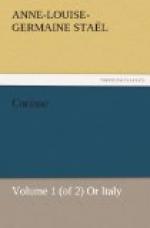Lord Nelville thought also, that scenes of tragedy and the most moving poetical fictions, ought to claim a preference in painting, in order that all the pleasures of the imagination and of the soul might be united. Corinne combated this opinion, fascinating as it was. She was convinced that the encroachment of one art upon another was mutually injurious. Sculpture loses the advantages which are peculiar to it when it aspires to represent a group of figures as in painting; painting when it wishes to attain dramatic expression. The arts are limited in their means, though boundless in their effects. Genius seeks not to combat that which is in the essence of things; on the contrary, its superiority consists in discovering it.—“As for you, my dear Oswald,” said Corinne, “you do not love the arts in themselves, but only on account of their relation with mind and feeling. You are only sensible to that which represents the sorrows of the heart. Music and poetry agree with this disposition; whilst the arts which speak to the eyes, though their signification be ideal, only please and interest us when the soul is tranquil and the imagination entirely free; nor do we require, in order to relish them, that gaiety which society inspires, but only the serenity which beautiful weather and a fine climate diffuse over the mind. We must be capable of feeling the universal harmony of nature in those arts which represent external objects; this is impossible when the soul is troubled, that harmony having been destroyed in us by calamity.”—“I know not,” replied Oswald, “whether my taste in the fine arts be confined to that alone which can recall the sufferings of the soul; but I know, at least, that I cannot endure the representation of physical pain. My strongest objection,” continued he, “against Christian subjects in painting, is the painful sensations excited in me by the image of blood, wounds, and torture, notwithstanding the victims may have been animated by the noblest enthusiasm. Philoctetus is perhaps the only tragical subject in which bodily ills can be admitted. But with how many poetical circumstances are his cruel pangs surrounded? They have been caused by the arrows of Hercules. They will be healed by the son of AEsculapius. In short, the wound is almost confounded with the moral resentment produced in him who is struck, and cannot excite any impression of disgust. But the figure of the boy possessed with a devil, in Raphael’s superb picture of the Transfiguration, is a disagreeable image, and in no way possesses the dignity of the fine arts. They must discover to us the charm of grief, as well as the melancholy of prosperity; it is the ideal part of human destiny which they should represent in each particular circumstance. Nothing torments the imagination more than bloody wounds and nervous convulsions. It is impossible in such pictures not to seek, and at the same time dread, to find the exactness of the imitation. What pleasure can we receive from that art which only consists in such an imitation; it is more horrible, or less beautiful than nature herself, the moment it only aspires to resemble her.”




